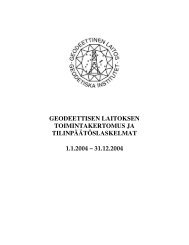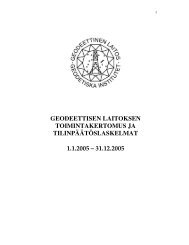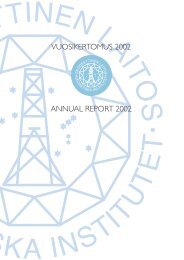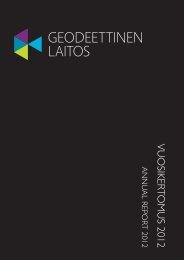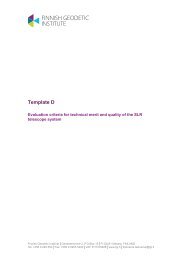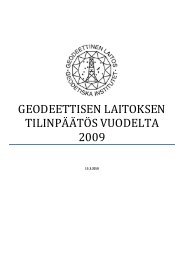Invitation to Tender for Satellite Laser Ranging Telescope System
Invitation to Tender for Satellite Laser Ranging Telescope System
Invitation to Tender for Satellite Laser Ranging Telescope System
You also want an ePaper? Increase the reach of your titles
YUMPU automatically turns print PDFs into web optimized ePapers that Google loves.
mode entails that the telescope operates otherwise au<strong>to</strong>nomously but<br />
accepts pointing and speed commands from the SLR operating<br />
software.<br />
3.1.3. Possible approaches <strong>for</strong> this <strong>Invitation</strong> <strong>to</strong> <strong>Tender</strong><br />
There are currently two fundamentally different basic approaches <strong>for</strong><br />
the optical systems (telescopes) used by SLR stations worldwide: 1)<br />
the monostatic system, where the transmitted and received laser<br />
pulses both travel on the same optical path through the main aperture,<br />
and 2) the bistatic system where a separate smaller telescope is used<br />
<strong>for</strong> transmitting the laser pulse and a larger main telescope <strong>for</strong><br />
receiving the return pulse. Both approaches are used in the satellite<br />
laser ranging community and both have some advantages and<br />
disadvantages. Here the basic differences between the two different<br />
optical setups and how they relate <strong>to</strong> this <strong>Invitation</strong> <strong>to</strong> <strong>Tender</strong> are<br />
presented. Due <strong>to</strong> several fundamental differences in the design and<br />
operation of the SLR system between the monostatic and the bistatic<br />
approach, some minimum requirements as well as award criteria <strong>for</strong><br />
technical merit and quality are specific <strong>to</strong> the approach presented in the<br />
tender.<br />
Regardless of the optical system approach, <strong>to</strong> minimize the<br />
background noise the field of view of the detec<strong>to</strong>r should be small<br />
(compared <strong>to</strong> FoV's of astronomical systems). The receiving optical<br />
system should have such a focal length / aperture ratio that <strong>for</strong>ms a<br />
field of view of a square arcminute or less on the detec<strong>to</strong>r (the final<br />
value is TBD between the Contracting Authority and the winning<br />
tenderer, and somewhat dependent on the optical system).<br />
Monostatic system<br />
In the monostatic system, both the laser and the detec<strong>to</strong>r are located in<br />
the Coudé focus of the telescope, which is located on an optical bench<br />
in a climate controlled room (which in Metsähovi will be located on<br />
s<strong>to</strong>rey below the telescope). In this setup the received and transmitted<br />
pho<strong>to</strong>ns are transmitted <strong>to</strong> the required direction through the same<br />
optical path. The direction of the beams can be accomplished either<br />
outside of the telescope at the Coudé room, or in the optical system of<br />
the telescope. Related <strong>to</strong> this, a major challenge <strong>for</strong> monostatic kHz<br />
system is the amount of light originating from the transmitted pulse that<br />
is backscattered from the telescope and related optics <strong>to</strong> the detec<strong>to</strong>r<br />
where it acts as noise. This is especially the case when using 2 kHz<br />
fire rate as multiple pulses are travelling through the telescope at the<br />
same time. As a minimum requirement (cf. Appendix 2) the tenderer<br />
offering a monostatic system shall describe a solution <strong>for</strong> the<br />
separation of the transmitted and received paths. This can be<br />
accomplished with supplementary documentation and with references<br />
7



